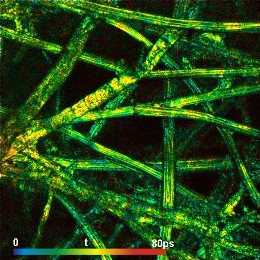We describe picosecond time-resolved optical signal recording in the spectral range from 900 nm to 1700 nm. The system consists of an id Quantique id220 InGaAs SPAD, a bh SPC‑150 TCSPC device, and a bh BDS‑SM 1064 nm ps diode laser. In contrast to earlier InGaAs SPADs the id220 works in a continuous (asynchronous) mode. The id 220 / SPC‑150 combination can be operated at a pulse repetition rate in the 10 to 100 MHz range. As a result, there is virtually no pile-up distortion, and advanced multi-dimensional TCSPC modes are applicable. The width of the temporal IRF (Instrument Response Function) is about 230 ps, including laser pulse width and pulse dispersion in the optics. We demonstrate the application of the system to the recording of time-of-flight distributions in turbid media, for fluorescence decay measurement, and for fluorescence lifetime imaging (FLIM) in combination with fast galvanometer scanning. For more details please see application note ‘TCSPC at Wavelengths from 900 nm to 1700 nm‘.
Back to News

